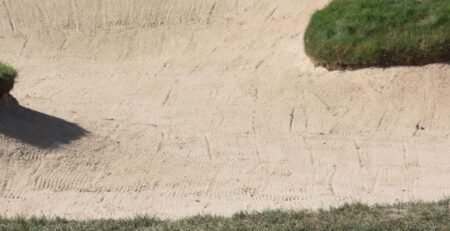How to Practice Effectively: Tips for Making the Most of Your Time on the Range
Effective practice is the key to improving your golf skills and taking your game to the next level. While playing rounds on the course is important, dedicating time to focused and purposeful practice sessions is where true progress is made. But don’t stress! D&A Golf here to provide you with valuable tips and strategies to help you make the most of your time on the range and to optimise your practice sessions.
Becoming a better golfer requires a deliberate approach, setting specific goals, and implementing effective techniques to refine your swing, improve your accuracy, and enhance your overall performance.
The importance of setting specific and achievable goals
Setting specific and achievable goals is crucial for effective golf practice. Without clear goals, it becomes challenging to measure progress and stay motivated. By defining specific objectives, such as improving your driving distance or reducing your putting strokes per round, you create a roadmap for your practice sessions. These goals provide focus and direction, helping you prioritise your efforts and track your improvement over time.
Strategies for goal setting in golf practice
To set meaningful goals for your golf practice, consider the following strategies:
Be specific: Instead of setting a general goal like “improve my golf game,” break it down into specific areas you want to focus on, such as improving your accuracy with irons or developing a consistent putting stroke.
Make them measurable: Goals should be quantifiable so that you can track progress. For example, aim to reduce your average score by a certain number of strokes or increase your fairways hit percentage.
Keep them achievable: While it’s important to challenge yourself, set goals that are within reach. Unrealistic goals can lead to frustration and demotivation. Gradually increase the difficulty as you achieve milestones.
Set short-term and long-term goals: Break down your goals into short-term objectives that you can work on within a few weeks or months, as well as long-term goals that you strive to achieve over a more extended period.
Creating a practice plan and schedule to optimise time on the range
Developing a practice plan and schedule helps you optimise your time on the range and ensures that you cover all aspects of your game. Consider the following steps when creating your practice plan:
• Assess your strengths and weaknesses: Identify the areas of your game that require the most improvement. This could be driving, iron play, short game, or putting.
• Allocate time for each aspect: Dedicate specific practice sessions to different areas of your game. For example, focus on driving and long irons one day, and then shift to short game practice the next.
• Include warm-up and cool-down routines: Prioritise warming up your body with dynamic stretches and exercises before practice to prevent injury and optimise performance. Incorporate a cool-down routine to aid recovery and reduce muscle soreness.
• Practice with purpose: Instead of mindlessly hitting balls, structure your practice sessions with specific drills and exercises targeting your goals. Work on technique, shot accuracy, distance control, and situational scenarios.
• Track your progress: Keep a practice journal or use a smartphone app to record your practice sessions, track your goals, and evaluate your performance over time. This provides valuable feedback and helps you adjust your practice plan accordingly.
By setting specific and achievable goals and creating a well-structured practice plan, you can optimise your time on the range, focus your efforts, and make significant strides in improving your golf skills. Remember, effective practice is about quality, not just quantity, so make every practice session count toward your goals.
The importance of warming up the body before practice
Warming up the body before a practice session is essential for injury prevention and optimal performance. It helps increase blood flow to the muscles, loosens joints, and prepares the body for the physical demands of golf swings. By incorporating a warm-up routine into your practice sessions, you reduce the risk of strains, pulls, and other injuries that can hinder your progress.
Dynamic stretches and exercises for golf-specific movements
To effectively warm up your body for golf practice, consider incorporating the following dynamic stretches and exercises:
• Arm circles: Stand with your feet shoulder-width apart and extend your arms out to the sides. Make small circular motions with your arms, gradually increasing the size of the circles. This helps warm up the shoulder muscles and promotes flexibility.
• Torso twists: Stand with your feet shoulder-width apart and place your hands on your hips. Rotate your upper body from side to side, engaging your core muscles. This exercise helps loosen the spine and prepares your torso for rotational movements during the golf swing.
• Hip swings: Stand in a staggered stance with one foot forward. Swing your back leg forward and backward, focusing on engaging the hip and glute muscles. Repeat on the other leg. This exercise helps improve hip mobility and stability.
• Club swings: Take a golf club and perform controlled swings in different planes, mimicking the movements of your golf swing. Start with smaller swings and gradually increase the range of motion. This exercise helps activate the muscles used in the golf swing and improves coordination.
Mental preparation techniques for focused and productive practice sessions
Preparing mentally for your practice sessions can enhance focus, concentration, and overall productivity. Consider incorporating the following techniques:
• Set intentions: Before starting your practice, set clear intentions or goals for the session. This could be focusing on a specific aspect of your swing, improving consistency, or maintaining a positive mindset throughout.
• Visualisation: Take a moment to visualise yourself executing successful shots and performing well during your practice. Visualise the ball flight, the sound of a solid impact, and the desired outcomes. This technique helps program your mind for success and builds confidence.
• Breathing exercises: Practice deep breathing exercises to calm your mind and centre yourself before each shot. Focus on slow, controlled breaths, inhaling deeply through your nose and exhaling slowly through your mouth. This helps reduce tension and promotes relaxation.
• Mindfulness and present moment awareness: Stay present and focused on each shot during your practice. Avoid distractions and let go of any past or future thoughts. Direct your attention to the sensations of your body, the sound of the club striking the ball, and the flight of the ball. This promotes a state of flow and improves concentration.
Tips for improving grip, stance, alignment, and posture
Grip: Achieving a proper grip is crucial for control and power. Practice holding the club with a neutral grip, with the “V” formed by your thumb and index finger pointing towards your trail shoulder (right shoulder for right-handed golfers). Avoid gripping the club too tightly, as it restricts wrist movement.
Stance: Position your feet shoulder-width apart, parallel to the target line. Distribute your weight evenly on both feet, with a slight bend in your knees. Maintain a balanced and athletic stance that allows for stability during the swing.
Alignment: Ensure your body, clubface, and target line are aligned. Use alignment aids or targets to guide you. Align your feet, hips, and shoulders parallel to the target line. This helps promote a consistent swing path and accurate shots.
Posture: Maintain a relaxed and athletic posture throughout your swing. Bend from your hips, keeping your back straight. Allow your arms to hang naturally, creating a slight tilt from your shoulders to your waist. This posture helps facilitate a fluid and powerful swing.
Drills and exercises to enhance swing mechanics and ball striking
• Mirror drills: Use a mirror to check your grip, stance, alignment, and posture. Practice your setup in front of the mirror, making adjustments as needed. This visual feedback helps develop muscle memory and ensures proper positioning.
• Slow-motion swings: Perform slow-motion swings to focus on the correct sequence of the golf swing. Pay attention to your body rotation, weight transfer, and club position throughout the swing. This drill promotes better mechanics and helps ingrain proper swing fundamentals.
• Impact drills: Use impact bags or strike mats to practice ball striking. Focus on achieving a square clubface at impact and maintaining a balanced finish. This drill helps improve consistency, accuracy, and compression of the golf ball.
• Alignment sticks and targets: Place alignment sticks or use visual targets on the range to enhance alignment and swing path awareness. Incorporate these tools into your practice to develop a more consistent swing and improve your ability to hit targets accurately.
By dedicating time to work on the fundamentals of grip, stance, alignment, and posture, and incorporating relevant drills and exercises, you can refine your swing mechanics, improve ball striking, and ultimately enhance your overall golf game. Remember that consistency and mastery of the fundamentals lay the groundwork for continued skill development and success on the course.
Tips for practicing specific skills such as driving, iron play, chipping, and putting
Driving: Work on consistency and accuracy by hitting a series of drivers with a specific target in mind. Experiment with tee height, ball position, and swing tempo to find the optimal combination that produces the desired ball flight and distance.
Iron Play: Devote time to practicing your iron shots at various distances. Create a target range and aim for specific landing zones to improve your distance control and accuracy. Focus on proper ball contact and maintaining a consistent swing tempo.
Chipping: Set up a chipping area with different targets and practice varying distances and lies. Work on developing a consistent technique and the ability to control trajectory and spin. Experiment with different clubs and shot options to expand your repertoire.
Putting: Designate a putting green or use a practice putting mat to refine your putting stroke. Work on distance control, aiming, and reading greens. Incorporate drills and games that simulate different putting scenarios to improve your feel and confidence on the greens.
Incorporating practice drills and games to simulate on-course situations
To enhance your performance on the course, it’s essential to simulate on-course situations during practice. Here are a few practice drills and games that can help:
• Course management simulation: Play a simulated round on the range by imagining specific holes and targets. Practice selecting the appropriate club, visualizing the shot, and executing it with the same focus and strategy as you would on the course.
• Pressure drills: Create pressure situations during practice by setting goals and consequences for achieving or missing them. This helps simulate the pressure you may experience on the course and trains you to perform under challenging circumstances.
• Skill-building games: Engage in practice games that focus on specific skills or scenarios, such as hitting to specific targets, playing to different yardages, or practicing different shot shapes. These games make practice more enjoyable and improve your ability to execute shots under various conditions.
• By targeting specific skills, practicing with intention, and incorporating drills and games that simulate on-course situations, you can accelerate your skill development and transfer those skills effectively to the golf course. Consistent and focused practice in these areas will ultimately lead to improved performance and greater confidence during your rounds.
The importance of introducing variability in practice routines
While it’s crucial to work on specific skills, incorporating variability into your practice routine is equally important. By introducing different challenges, you can develop adaptability and improve your ability to handle various situations on the golf course. Practice variability helps prevent monotony and keeps your mind engaged, leading to better skill acquisition and retention.
Using different clubs, targets, and shot shapes to develop adaptability
To enhance your adaptability, practice with a variety of clubs, targets, and shot shapes. Experiment with different clubs and practice hitting shots at different distances and trajectories. This helps you develop a better understanding of how each club performs and how to adjust your swing to achieve specific shot shapes. Additionally, practicing with various targets—both on the range and on the course—improves your ability to adapt to different pin positions and course layouts.
Simulating on-course scenarios to enhance decision-making and shot execution
Practicing on-course scenarios is a valuable way to improve your decision-making skills and shot execution. Simulate different situations you encounter during a round, such as hitting from uneven lies, dealing with obstacles, or strategizing for specific holes. By visualizing and executing these scenarios in practice, you train yourself to make better decisions and execute shots more effectively when faced with similar situations during a round.
Incorporate practice drills and games that simulate real-life playing conditions. For example, play a “scramble” game where you intentionally hit errant shots and practice recovery shots to simulate challenging situations on the course. This not only improves your shot-making abilities but also boosts your confidence in handling unexpected circumstances.
Utilizing feedback mechanisms to assess performance
Feedback is essential for effective practice and skill development. Incorporate feedback mechanisms into your practice sessions to assess your performance objectively. This can be done through various means, such as working with a D&A Professional, practicing with a training aid, or using video analysis. Feedback helps you identify areas for improvement and provides insights into your technique, swing mechanics, and overall performance.
Recording and reviewing practice sessions for self-analysis
Recording and reviewing your practice sessions is a powerful tool for self-assessment. Set up a camera or use a smartphone to record your swings and practice drills. Take the time to review the footage, analysing your technique, body positioning, and any flaws or inconsistencies. This self-analysis allows you to identify patterns, make adjustments, and track your progress over time.
Seeking professional guidance and utilizing technology for objective feedback
To gain valuable feedback and improve your practice effectiveness, consider seeking guidance from one of our golf professionals. With our tuition, we can provide expert analysis, personalised feedback, and tailored drills to address specific areas of improvement. They can help you identify strengths and weaknesses, offer technical advice, and provide guidance on structuring your practice sessions effectively.
Maintaining proper practice etiquette and respecting others on the range
Practicing golf requires not only individual focus but also consideration for others sharing the practice area. It is important to adhere to proper practice etiquette to create a harmonious environment for everyone. This includes respecting personal space, not interrupting other golfers during their swings, and adhering to any rules or guidelines set by the facility. Remember to pick up after yourself, keep noise levels to a minimum, and be mindful of the pace of play.
Techniques for staying focused and avoiding distractions during practice
Distractions can hinder your practice sessions and impede your progress. Develop techniques to maintain focus and minimise distractions while practicing. Find a quiet area on the range, away from unnecessary noise and disturbances. Practice mindfulness techniques to stay present in the moment and block out external distractions. This can involve deep breathing exercises, visualisation, or creating a mental routine before each shot. Setting specific goals for each practice session can also help maintain focus and provide a sense of purpose.
Building a routine and establishing a productive practice mindset
Establishing a routine and adopting a productive practice mindset can significantly enhance your practice sessions. Create a pre-practice routine that prepares you physically and mentally for the session ahead. This can include warm-up exercises, stretching, and visualisation techniques. Set specific objectives for each practice session, whether it’s improving a particular aspect of your game or working on specific drills. Break down your practice into smaller segments, focusing on different skills or areas of improvement.
Consistency is key in developing a productive practice mindset. Regularly schedule practice sessions and commit to them as you would with a game or tournament. Avoid rushing through your practice or mindlessly hitting balls without a purpose. Instead, approach each shot and drill with intention and focus on quality over quantity. Take the time to analyse and reflect on your performance after each practice session, identifying areas that need further attention and adjusting your practice routine accordingly.
Recognising the importance of rest and recovery in practice
While practice is essential for skill development, it is equally important to recognise the significance of rest and recovery in optimizing your performance. Pushing yourself too hard without allowing for adequate recovery can lead to diminished results and increased risk of injury. Understand the value of rest days in your practice schedule to give your body and mind time to recuperate and recharge.
Tips for managing physical and mental fatigue during extended practice sessions
Extended practice sessions can often lead to physical and mental fatigue, which can hinder your progress. To effectively manage fatigue, consider breaking up your practice sessions into shorter, focused intervals. Take regular breaks in between to rest and rejuvenate. Listen to your body and adjust the intensity and duration of your practice accordingly. It’s crucial to strike a balance between pushing yourself and avoiding overexertion to prevent burnout and maintain consistency in your practice routine.
Nutrition and hydration play a vital role in supporting your overall performance on the golf course. Properly fuelling your body before, during, and after practice can enhance your energy levels, endurance, and focus. Consume a balanced diet that includes lean proteins, complex carbohydrates, and healthy fats to provide sustained energy throughout your practice sessions. Stay hydrated by drinking plenty of water before, during, and after practice to prevent dehydration, which can negatively impact your performance and recovery.
In conclusion, practicing effectively is crucial for improving your golf skills and reaching your full potential on the course. By following the tips and strategies outlined in this article, you can maximise the productivity of your practice sessions and make significant progress in your game.
Remember, practice is not just about hitting balls on the range but also about deliberate and purposeful training. Consistency and dedication are key. Embrace the process of improvement, stay patient, and celebrate small victories along the way.











